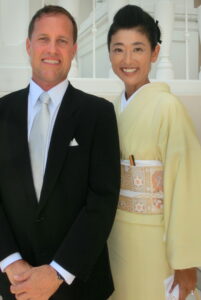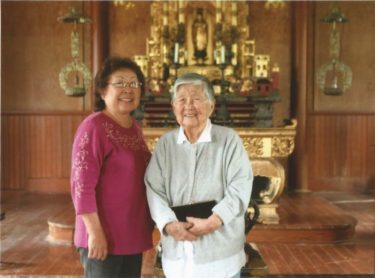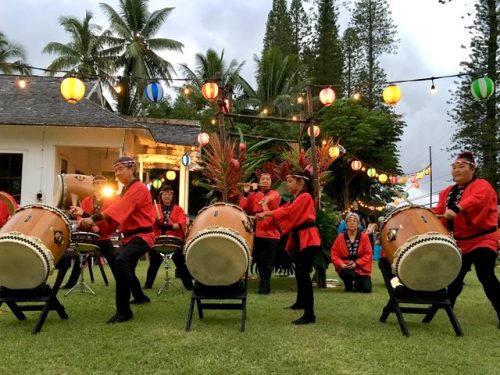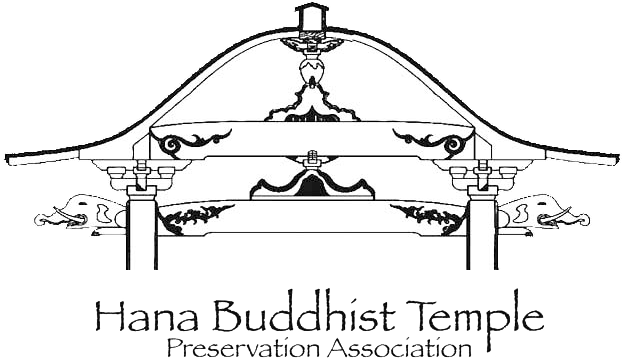The Hana Buddhist Temple and The People Who Are Saving It
Hawaii Historic Foundation Interview
with Miho & Joe Brower - 5/17/2018

Historic Hawai‘i Foundation: Please describe the genesis of the Hana Hongwanji Gakuen Temple restoration project.
Joe & Miho Brower, Hana Buddhist Temple Preservation Association: The Hana Temple is a gem hidden in plain sight of the tiny coastal town. My wife and I fell in love at first site with the Temple shortly after arriving in Hana nearly twenty years ago. I, being a builder, was drawn by the style, workmanship and aura of the building while my wife, a Japanese Buddhist, had a familiar spiritual connection to the temple. Out of admiration and wanting to be involved with the temple and her grounds we wrote a letter to the Temple caretaker, a stern original member who had been the caretaker of the Temple since returning to Hana from WW II, asking to be given a chance to help out with the maintenance. The letter was returned with the words “The Answer is No – Stay Away” written in black sharpie. Some years later, in 2012, the aging caretaker fell ill and was forced to leave Hana for an extended hospitalization. At this point the building was showing more severe signs of dilapidation with components of the roof, front beams and portico failing. A letter we wrote thanking the Uncle for his devotion to and veneration of the Temple was unexpectedly responded to with a positive note conveyed through his niece, Myrna Costello, indicating that our help would be appreciated. That was the point at which we started actively working on the Temple. We joined together with Myrna and united with a couple other like minded Hana citizens to form our nonprofit group in 2015, devoted to the preservation of the historic Temple.
HHF: Who is involved in the project?
HBTPA: A small group of community volunteers who are dedicated to save this historic building. Many are Japanese and want their heritage protected. There are Buddhist practitioners who want a place to practice their faith and have a place for others to practice theirs. A historian who wants preservation of this historical building.
HHF: Where are you now in the process?
HBTPA: As of this writing we are awaiting approval of an emergency permit to replace the deteriorated portico of the building. This part of the Temple is in need of repair as a leak in the roof valley has led to the rot of the main beam and the prominent posts at the entrance.
We have Jim Neiss, a historic architect, (HHF note: Jim is an HHF board member) who is under contract and is guiding us. Plans have been drawn up through his office and are being given out to contractors for bid. We need to finalize a contractor who will do the work. Once accomplished we will have the necessary information to apply for grants as we will know the full scope of the work. Under Jim’s guidance with emergency permits from the County, we will begin the restoration. There is continuous fund raising within the community and letters for donations.
HHF: What’s special about the temple and why does preserving it matter?
HBTPA: The temple is special in many ways. It not only represents the culmination of the hard work and culture of immigrant Japanese sugar workers, it represents the hope for a prosperous community in their new home of Hana, Maui. To allow this historic gift from our kupuna to wither away would be like turning our backs on our history, culture and indeed our heritage. By preserving the Hana Temple we reestablish a historic lightning rod location for community events, cultural activities, and a venue for spiritual awakening. The future outlook for the Hana Community is at stake.
The Hana Buddhist Temple is the only dedicated HISTORIC building in Hana which represents the Japanese community and is unique to the cultural heritage. This Temple is of historical significance and was built with the hands of local Japanese people in the traditional art forms of their day. Alter pieces and artwork were brought from Kyoto and added to the temple which stands in place. Only time has moved forward. To protect and preserve this unique building for historical, cultural reasons and serve as a future gathering place for all members of Hana is of upmost importance to the community.
The Temple has many memories of past Hana residents and is the destination of many living throughout the world today who come to pray and show reverence for the departed souls of their ancestors. The temple also is a portal through which those ancestral spirits return for Obon and when evoked from prayer.
HHF: What were/are some of the challenges to moving forward with the project?
HBTPA: Getting a group of dedicated volunteers with diversified skills, writing bylaws, 501 C3 applications, writing grants, negotiating the lease from mainland corporate owners of the land, all while the land is for sale, has complicated the process. Finding professionals to help us and guide us through the steps. Having been dissociated from the Hongwanji, and being isolated in remote East Maui, we have few resources.
The biggest challenge lying ahead for the project at this point is raising the money needed for the entire renovation as well as finding the builders who are skilled enough to complete a proper renovation of this historically significant Temple.
HHF: How were you able to overcome them?
HBTPA: Months on months to years of dedicated work and holding a vision for the preservation of the temple. Reaching out to the community to educate and ask for help and being warmly supported. Seeing the building deteriorate before our eyes has been a large motivation. When Jim Neiss saw it, his heart was touched and he jumped in immediately to help and direct us.
We have raised nearly enough money in our three years of fund raising to replace the portico that is presently braced up for added support. Fundraising has come through the hard work, dedication, and team work of the HBTPA along with growing community financial support. We will have our Fourth Annual Bon-dance festival this September and we continue to do other fundraisers such as the Hana Canoe Regatta, and Kadomatsu sales in December.
HHF: What’s your community’s vision for the future of the temple?
HBTPA: Most community members have expressed their support for renovating the temple on the grounds that it would be a shame to allow one of Hana’s most historically significant buildings (that was once an epicenter of positive energy for the community) to deteriorate and fall to the wayside. Others look forward to having a venue open to future generations for community based classes and activities we plan to endorse once the structure is made ready. An active Temple will be a torch of hope handed down for generations to come.
HHF: What advice do you have for other communities working to preserve a historic place?
If I were to give advice to other communities trying to preserve a historic place I would stress to them the importance of team work in the approach to a preservation effort. It is much more fun and meaningful to accomplish the goal with a group of people from a community with like minds.
Myrna Costello’s Childhood Memories

Myrna Costello with her mother, Sumie Sumida, age 98, just before she passed, in 2015.
My name is Myrna Sumida Costello, and I am a third generation Japanese American, born to plantation workers in Hana.
I remember a time when the plantation workers in Hana made up a large part of the community, and the Buddhist Temple was an important part of their social, recreational and religious activities. My grandfathers and my dad played a part in building the temple and my grandmothers and mom cooked for the workers and for every occasion, be it a funeral, a wedding, New Years, etc.
My memories of plantation life in Hana through the eyes of a young girl are so vivid and warm. I do this work now to preserve a very significant part of my heritage. I do this to honor my ancestors and to remember a part Hana’s history that I was so fortunate to be a part of.
Why the Temple Matters
by Cynthia K. Day, Board Member,
Hana Buddhist Temple Preservation Association
The Hana Hongwanji Gakuen Temple still stands as a historic cultural beacon in the Hana community. Built in the mid 1940’s by the Japanese community of Hana, it holds an important significance to the dedication of spiritual and cultural values of the Japanese people that came to Hana to work, and make this area their home. There are those still living in Hana who fondly remember going to the Temple with their families for services, weddings and cultural functions such as the Bon Dance. Times of war changed everything for the Japanese community. Many were taken away or forced to move, and through the years the Temple has greatly suffered from this loss.
When I first arrived in Hana, in 1978, the Temple was still open to the community and various classes were held in the room below the Temple. I remember the first time I saw the Temple I was in awe of its unique architecture and presence, which drew me to walk through the doors, to sit quietly, and take in the simplistic beauty of the decor as well as the intricate adornments on the altar. I visited the Temple a number of times just to sit quietly and reflect. Then one day it was closed to the public, never to be used again for almost 40 years! A very sad day for Hana!
On September 9, 2017 we held our 3rd annual Bon Dance on the Temple grounds. This was the first Bon Dance actually held there in 40 years!! The evening evoked the spirit of tradition in honoring the ancestors with Japanese music, dance and performances by the Taiko Drummers of Maui. The entire community came out to celebrate and support our fundraising efforts. It was an incredible evening! Many longtime community residents shared their joy in seeing the Bon Dance held on the Temple grounds again, bringing life back to this important cultural icon of our community. The altar was lit with candles and incense and the doors of the Temple were once again opened for eyes to behold beauty of the Buddha and the gold leaf traditional decor on the altar. Due to the condition of the portico, visitors were not allowed inside, but being able to view it in candle light from a distance created its own magic!!
In a discussion with my friend Hilary Harts, she mentioned that she was a board member for the newly formed Hana Buddhist Temple Preservation Association, and they were diligently working to secure a lease on the property so the Temple could be saved from its current deteriorating condition. This was music to my ears, since I have always loved the Temple. I offered to assist in whatever was needed to move this project forward. I am honored to say that I am now a member of the board, and we are working to acquire the funds to restore the structure of the Temple before it’s too late. Recently theTemple portico had to be re-enforced with extra structural supports due to is deteriorating condition. We have an architect working on an emergency permit with the county so we can begin the construction work to repair this part of the Temple. The board is continuing fundraising efforts, and the Association will be applying for restoration grants this year. Time is of the essence if we want to save this building, which I believe along with most of our community, is an important part of the Hana’s unique history and needs to be preserved for the generations to come.
Community musings from the September 9, 2017 Bon Dance. The first Bon Dance actually held at the Temple in 40 years!!

Picture by Asa Elison
From The Attendees:
Hāna Hongwanji Temple: A Vision of inclusion, culture and community.
A way to connect the cultural dots for the newer generations.
Bringing culture back to the community.
New experience for young people. Grown children who were little when the last Bon Dance happened were there sharing this experience with their children and connecting them to their cultural roots.
Last bon dance of the year.
Created a sense of pride.
Hāna is an ancestral place. People come from all over to participate in the Bon dance, Taiko drummers and Japanese Bon dancers and the temple community puts them up in special places. Hāna—means sacred spiritual work—event which was finale of season was filled with a joyousness, real eagerness to participate.
Revival of the cultural past.
Elders came out.
Magical, magical night with lanterns, kimono, nature, temple, food, many generations coming together.
Bon Dance event created a powerful momentum to carry this sacred work to revive the temple forward.
The community is sharing the vision/the board is doing the work with a sense of reverence & gratitude to help midwife this transformation thanking the community for supporting them in this vision
It’s a feel good thing. Because the community is carrying the vision of the revival of the temple for use as a temple but also as a useful, vibrant part of the community. Perpetuating the history in the best sense.
Discovering the Temple
by Bill Sides, Consultant
Hana Buddhist Temple Preservation Association
I have lived in Hana since 1981 and was always a bit curious about the Buddhist Temple I had been driving by over the years. I was never into organized religion but I thought Buddhism to be one of the better ones. I also thought the Temple had a bit of structural charm to it as well. When Cynthia asked me if I could help with the Buddhist Temple Restoration I was busy with “Festivals of Aloha” along with two other projects and was initially reluctant to add additional work. Because it was one of only four historical buildings in Hana and such a part of its history I began to think of it as a legacy type project and decided to take on the work. To be honest, I also thought I could supplement my social security as well but I soon realized we needed most of the hard earned funds to go directly into the project. It then became a labor of love.
After all of my years in Hana I had never been inside of the Temple and I finally had a reason to walk through it. That began for me the discovery of its history and a fascination with how the structure must have once looked. I would have to say, somewhat of an obsession. It began when Randy Orozo showed me remnants of the original carvings and symbols that at one time adorned the building’s roof structure. I had no idea that they had ever existed and now I would have to figure out how to best restore them.
Being listed on the National Register of Historical Places requires that the building be restored to its original condition or better. The challenge was determining how it must have looked and then recreating the original carvings from the remnants that were left. An additional challenge was to make them last several years exposed to the same elements that destroyed the originals. You can see the process I used at “Restoring the Decorative Carvings” on the “Restoring the Temple” page.
Trying to determine the colors, using the few photos available, was a perplexing puzzle.
Below you can see the difference in the pictures of the Temple depending on the year they were taken.

Below is an example of how we went about determining the colors and their location on a building that had been painted over several times.

On the left is the carving from the building that had been painted over and we could not assume that it matched the original. It was located under the roof line and protected from the weather. You could see the perimeter color was black and the vines and stylistic flowers were a blue-green with the color on the flowers fading from the outside inward. From the old black and white picture in the center you could see the vines appear to be black rather than blue-green. The typical Japanese style as shown on the right has a colored background with black vines and stylistic flowers with the color on the flowers fading from the inside outward. From the left and center pictures we concluded that the background was most likely white with the typical Japanese black vines but with the colors on the flowers fading from the outside in. So we believe the vines were black not blue-green. From chipping the surface paint off of the crane we found that it was most likely a reddish-orange body color not white. From other pictures we believe the legs and beak were a yellow-gold. Having determined, from the only remaining painted carving, what we believe the colors originally were we applied that paint scheme to the other destroyed carvings. There was no way to verify the color of the symbols, so based on other temples we arbitrarily decided to paint them a yellow-gold color. We are still working on the paint scheme and would appreciate any photos that might add clarity.
I always liked a good puzzle and this project was a good one. It has been fascinating working out how it must have looked when it was first built in 1940. The adults who were there have passed away and the children were too young to remember, so we know it will not be exactly the same but the challenge has been in trying. It being one of the most charming Buddhist Temples in Hawaii makes it well worth the effort.
